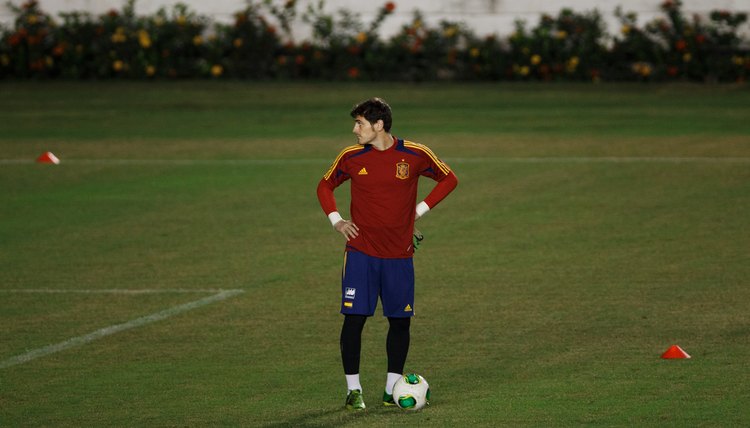Goalkeeper Exercises to Do Alone

In a perfect world, your team would have a goalkeeper’s coach and several assistants to provide you with customized drills, as well as half-field exercises recruiting a half-dozen teammates as an attacking squad to mimic game conditions. But as the Rolling Stones sing, "you can’t always get what you want” -- meaning that though you want to get better, your rec or even travel team doesn’t always have the resources. However, you can still polish your skills solo.
Field Exercises
You can take the ball out to the field and perform juggling, this time with your fists instead of your feet. Toss the ball in the air and continue punching it to keep it airborne to working on your parrying skills, recommend the authors of “Soccer Goalkeeping Training.” Tilt your head backward slightly and make light moves forward, backward or laterally to stay under the ball. Next, hold the ball overhead, and drop it behind you. Bend over, reach between your legs and try to catch the ball before it bounces; beginners can allow it to bounce once. This drill helps to build quick reaction times.
Wall Drills
Whatever kind of surface you can find -- a tennis hitting wall, the side of a recreation center, a warehouse or an indoor gym wall -- can be pressed into service for wall drills. Throw or kick the ball against the wall at varied heights and angles, and try to snag 100 rebounds in a row without dropping any, advise the authors of “Soccer Drills and Skills." Work particularly on catching high balls with the fingers of both hands. Catch and toss the ball over and over, bending your arms only at the elbows. As you become more proficient, substitute a medicine ball for a soccer ball.
Plyometrics
You can include jumping rope in your regimen, working up to 10 to 20 minutes of alternating fast and slow intervals. This solo exercise works all of the leg and foot muscles, requires mental sharpness to stay in rhythm, and provides both an anaerobic workout and a warm-up for other activities, notes coach Tim Mulqueen in “The Complete Soccer Goalkeeper.” Add agility work on a speed ladder and mini-hurdles, eventually while holding a ball, for additional conditioning.
Reflexes and Foot Skills
Return to the wall for a drill that improves your reflexes rather than your basic skills. The Tretiak shuffle entails standing 4 feet from the wall with a tennis ball in your right hand. Toss the ball underhand at the wall, shift to your right, and catch the rebound overhand in your right hand. Repeat with your left hand to work on hand-eye coordination. Wrap up with juggling with your feet this time instead of your hands, tapping the ball up with the top of your shoe to mimic the classic field player’s drill. Improved foot skills prove valuable for when you need to use your feet in goal.
References
Writer Bio
An award-winning writer and editor, Rogue Parrish has worked at the Washington Post, the Baltimore Sun and at newspapers from England to Alaska. This world adventurer and travel book author, who graduates summa cum laude in journalism from the University of Maryland, specializes in travel and food -- as well as sports and fitness. She's also a property manager and writes on DIY projects.
